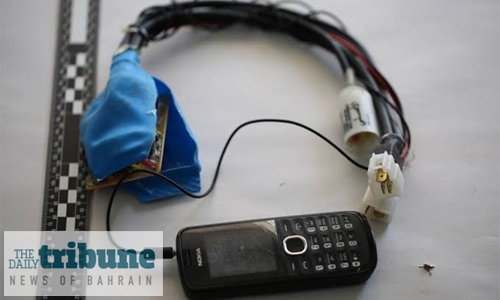Iran-made terror
Weapons inspectors have identified Iran as the source of military-grade explosives and electronic parts for home-made bombs that have been seized from militants in the Kingdom. Some are identical to those recovered from Houthi fighters in Yemen and from Iraq, and include radio-controlled electronics and parts to fit bombs on the underside of cars, an investigation by Conflict Armament Research found.
The findings are based on analysis of seized items by national security forces since 2013, when explosive devices used by militants in Bahrain increased in sophistication. They point to an Iranian role in some of the 32 home-made bomb attacks in the last eight years that have killed at least 21 security officials.
The report concludes by pointing out that militants in Bahrain and the Houthis may have a common source of explosive components, “some of which probably originate in Iran.” Bahrain has long blamed Iran for bomb attacks and for stoking anti-national activities. The most well-known of the underground groups, the Al Ashtar Brigades, has claimed responsibility for about 20 bombings including a 2014 attack that killed three police officers, including one from the UAE.
The US, which has its naval command headquarters in Bahrain, has backed the government’s claims that Iran is supporting violent opposition factions. It has imposed new sanctions on some Bahraini militant groups. The arms researchers said that identifying marks on some of the weapons seized had been “systematically obliterated” to try to hide where they were made.
“The frequency of mark obliteration is significantly higher for weapons documented in these cases than for any other region in which Car has collected data since 2011,” said its report, The IED Threat in Bahrain. It said the only other devices where so much effort had gone into grinding off manufacturers’ marks were those recovered from Houthi fighters in Yemen.
Dr Matthew Levitt, a senior fellow of the counter-terrorism programme at the Washington Institute for Near East Policy, said the report was further evidence of Iran’s interference in Bahrain. “This fits with Iran’s increasing strategic desire to flex its muscles in the region through this asymmetric warfare,” Dr Levitt said. “For very little money and fairly little risk, they were able to have a disproportionate effect not only on countries in the region, but more broadly in pushing back against US and British efforts to contain its nuclear programme and more malign activities in the region.”
The group said that from 2013, Bahrain security forces began to intercept boats in its territorial waters, with mixed cargoes of bomb-making gear and conventional military weapons. It said electronic material found in Bahrain were identical to parts found on board a cargo vessel, the Jihan 1, which US naval and Yemeni coastguard forces intercepted off Yemen’s southern coast in 2013.
“The components either originated in Iran or are linked to Iranian-backed supply networks in the region,” the researchers’ report said. The UN Panel of Experts on Yemen concluded in 2013 that crew members travelled to Iran where they were transferred by speedboat to the Jihan 1, which was 2 kilometres off Iran’s coast. It then sailed into Yemeni waters where it was intercepted before reaching the Houthi movement’s stronghold.
Related Posts

